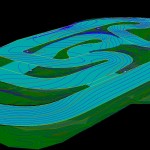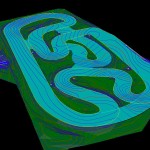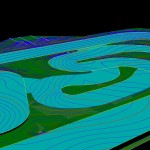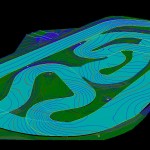On this page you will find information regarding the progress of the 2015 England Park Model Raceway racing surface redevelopment. There will also be regular updates outlining equipment and skills required to complete specific tasks and if you are able to help in anyway please contact the committee via email at secretary@qrccra.org.au
View the 2015 Redevelopment Image Gallery Here!
QRCCRA would like to thank the following companies for their support during the redevelopment of England Park Model Raceway:
Pre 2015 – The Story So Far…
Over the last 12 months the committee has sought advice from various experts in order to resolve the two main issues relating to the England Park Model Raceway racing surface. Here is what was concluded:
- The Bumps: Initially it was assumed that the polymer sealing layer, put in place during the last resurface, had separated from the lower surfaces and was causing the top track surface to ‘bubble up’ with changes in temperature. After consulting with experts from Fulton Hogan, Brisbane City Council and other asphalting contractors, a variety of possible causes were named and it was not possible to confirm that separation between layers was the issue. At this point the committee decided to have core samples of the track tested, the results of which showed minimal separation and almost zero permeability of the polymer layer. One area that the experts we consulted unanimously agreed on was the inadequate drainage currently in place. They were all able to point out evidence of water that was trapped in the infield and areas where this had caused deformation of the racing surface or instability in the track’s foundations. The instability in the subsoil combined with water trapped under the impermeable polymer layer was noted as another possible contributing factor to the bumps at the surface.
- Turn One Sinking: While it may seem simple to determine that instability in the subsoil is responsible for the sinking that is most evident on the outside of turn one, the solution is much more complicated. The possible solutions suggested range from the erection of a retaining wall below ground level around the outside of the corner, to the complete removal of turn one and laying a concrete base before resurfacing the track. Once again inadequate drainage was unanimously noted as the cause of the subsoil’s instability.
Using the above information it was determined that the following tasks must be integrated into the resurfacing works:
- Profile the current racing surface to remove the polymer layer that is preventing the movement of water vertically through the race track
- Improve the drainage through the installation of subsoil drains along both sides of the entire length of the track
- Remove turn one and replace foundations, to prevent future sinking
Note: Profiling refers to the removal a specified amount of asphalt from the race track’s surface.
January 2015 – Surveying and Planning…
During the first half of 2014, Andrew from Paveset was able to survey the current layout and use it to provide contractors with accurate measurements for quoting purposes. The track was then able to be plotted and modelled using specialist software, which showed up some flaws relating to drainage from the track surface and highlighted the need for profiling the track to a specific shape that would optimise drainage and decrease the amount of asphalt required to resurface the track.
Following consultations with members regarding the possibility of several changes and/or additions to the current layout some options were incorporated into the track design and a computer model produced (see below). The changes that will be made to the layout include opening up the existing cutouts to allow two way traffic, opening the back sweeper to make it a true high speed corner, lengthening the front straight and raising the exit of turn one to allow for the future addition of an oval layout, and the addition of a turn between the current turns one and two. Initially it was planned to retain the original track between turns one and two, however due to the change in elevation required to allow turn one to join turn three this was not possible. The new section will incorporate a short downhill run from the exit of turn one, through the changing camber of the new turn two, and up hill into a faster turn three (old turn two). The elevation changes in this section will offer unique challenges not found in any other model raceway in Australia.
Note: The following images do not properly represent the view from the driver’s stand.
Click here to download a motion fly over of the new layout (File Size: 41mb)
The last race meeting to be held on the current surface will be on the 28th of February and the track will be closed until works are completed, which is anticipated to be less than two months. The tasks that need to be completed during this time are listed below, if you are able to offer any assistance please contact the committee via email at secretary@qrccra.org.au
- Have under ground electrical lines located
- Develop drainage design with Darren Densley
- Finalise track design with “Paveset”
- Disconnect power and light fittings on Eastern lighting pole
- Relocate lighting pole
- Trench and install lighting electrical pit
- Refit and connect light fittings
- Move/remove Western spectator fence
- Lift and remove concrete curbs
- Lift and remove steel barriers
- Lift and remove obstructive marshal points
- Lift and remove pit lane curb and remove steel reo starter bars
- Trench and lay Aggie pipe and connect to pits (where possible)
- Profile existing surface using “Paveset” design
- Asphalt profiling waste to stay onsite and stock piled for later use
- Cut track and remove asphalt sections that are to be redeveloped
- Peg out new layout and supply cut numbers and depths
- Dig out and shape new sections at a depth 300mm below finished height
- Build up new sections in 100mm increments using stockpiled profiling waste
- Finish off remaining aggie pipe works on new sections
- Surface water drainage works will tie in with “Paveset” track design
- Reshape infield grassed areas to enhance drainage design
- Install drainage pits
- Tunnel bore under track to lay main drainage pipes
- Lay extra conduit for future services ie. Power for extra loops
- Carry out edge reinforcement where needed ie. Turn 3
- Lay down new asphalt
- Cut in new loop/s
- Cut in under pit wall drainage channel
- Reinstall pip lane wall
- Reinstall corner curbs
- Topsoil infield
- Lay turf
- Reinstall steel barriers
- Design and install new barriers where needed ie. New turn 1 section
- Paint curbs, start finish line, grid boxes etc.
- Reinstall spectator fence but make higher ie. 6-8ft







